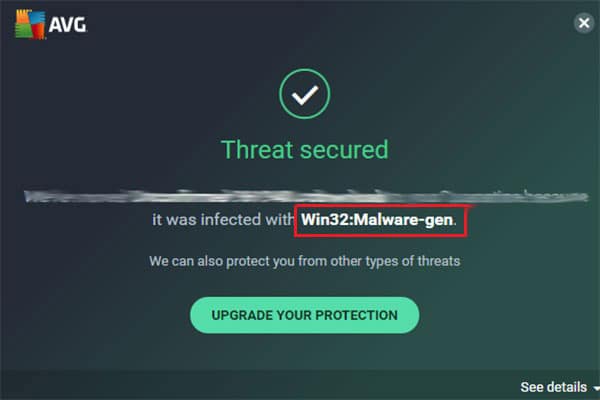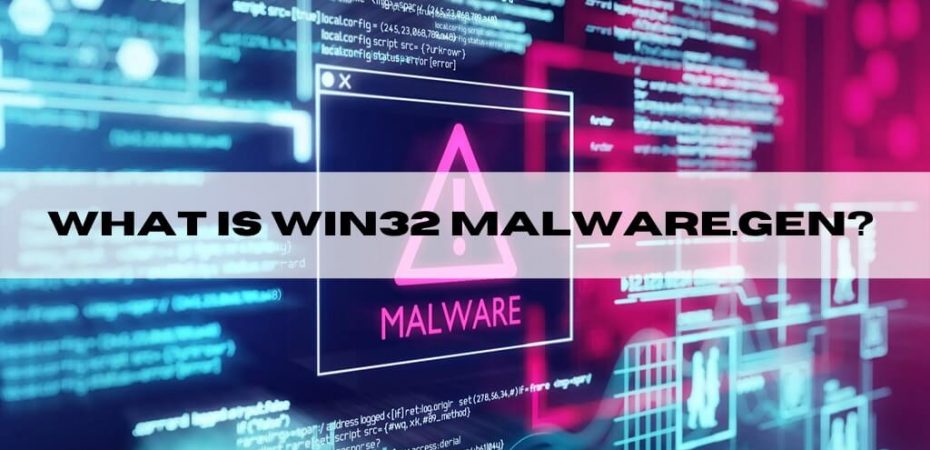To keep your computer safe, it is essential that you have an antivirus application installed. These applications ensure that none of the files stored on your computer are malicious and have possible viruses and malware that may cause security breaches and potential loss of data.
These antivirus applications work by using various methods to determine whether or not a file stored on your computer is malicious. It does so by comparing the content of the file against its database of threats. From there, it can analyze the behavior and structure of the files to see if it exhibits certain behaviors that are common to malware.
When such an antivirus program finds a file displaying suspicious behavior but does not match any known threat, you get an alert stating that it has detected a Win32: Malware-gen on your computer. This threat indicates that the antivirus found a 32-bit file on your computer that may be malicious and possibly cause harm to your data.
What is Win32 Malware.gen?

A Win32: malware-gen is a generic threat. It is essentially a suspicious file that is detected by the antivirus software installed on your computer. During its antivirus scan, it has found a file that does not outwardly match any kind of known malware threats that are present in the database of the antivirus software but may still be malicious.
Therefore, the antivirus software generates an alert to let you know that a 32-bit file on your Windows operating system is suspicious and should be looked into further.
There are two possibilities when you receive such an alert. One possibility is that the file that was reported to have a Win32 Malware.gen infection is not malicious. In this case, you do not have to take any action and can simply dismiss the alert. The second possibility is that the file is actually malicious. If it is and you do not remove it and instead install it, the file will alter the system settings. This change in system settings and registry will cause your computer to have poor performance and other security issues that may make it difficult to use your computer.
These malicious files that could possibly be downloaded are often Trojan horses. These can install additional malware, steal personal information, modify your system files, redirect you to suspicious domains, and more. Furthermore, removing such malicious files can be tricky, especially when they have dug their roots in deep.
What is Malware?

Malware is essentially an umbrella term and covers all kinds of malicious software. These softwares may include extremely dangerous backdoor tools or even harmless pop-up ads. The latter is annoying but not as dangerous. backdoor tools are dangerous because they allow criminals to have full control of your PC. Therefore, they can do whatever they wish and steal all your information if that is what they desire.
Criminals are usually behind the creation of malware, and they can program it to do various tasks. These malware can help them in more sinister crimes such as bribery, theft, and making money off of someone. They can also be used to simply annoy and inconvenience someone by showing them pop-up ads at certain intervals. Although not outrightly malicious, they can be annoying and intrusive.
Files that may contain malware
To protect yourself against malware, it is important that you know which files may contain it. Therefore, instead of trying to get rid of malware, you can prevent it from making a home in your computer from the get-go. Usually, the files that contain malware are executable files. These files are usually “.exe” file types. Files that contain documents such as scripts, word files, excel files, PDFs, and web pages are also common files that may contain malware.
Hence, it is always good to be wary of such files when downloading them off the internet or bringing them onto your computer by any means. You can always run them through an antivirus check so that you can double-check that they do not contain any obvious or hidden malware.
Aliases of a Win32 Malware.gen
A Win32 Malware. gen infection exists under many different names. Many of these names are detected by anti-malware software, but you too should know them,\ so that you can check the files that you download and lessen the load of the antivirus software. If you download these malware, it may cause many serious issues such as data loss, identity thrift, poor browsing experience, and more.
Some aliases of a Win32 Malware. gen include the following.
- Antiy-AVL
- AVG
- Fortinet
- Ikarus
- AhnLab-V3
- Microsoft
- Sophos
- BitDefender
- McAfee
- Antiy-AVL
- Comodo
- Fortinet
The Typical Behavior of Win32:Malware-Gen
Malware and Trojans are designed for specific purposes like data theft, keystroke recording, and so on. Below, we’ve included a handful of these Trojans’ activities, such as Win32 Malware. gen:
- Take your credit card information.
- Take your data, such as photos, files, and folders.
- Capture your keystrokes and information, such as passwords and login IDs.
- Keep track of and save your internet history.
- Third-party software can connect to your computer and access its resources.
- Send bogus software as well as computer updates to infect your computer further.
How to Prevent Malware
Rather than fixing a problem, it is always better to avoid it from the get-go. The best way to do it is to avoid any suspicious files at all. If there are any suspicious files on your computer, avoid opening them or scanning them with antivirus software beforehand. Usually, the suspicious files include files that you receive from other sources. Whether or not they are trusted or unknown, it is always better to check.
Another way to prevent malware is to avoid files received via USB. This is because, without the knowledge of the giver, their computer, file, and USB may have malware or virus installed, and they may not even know of it. You should also avoid downloading and installing files that come from high-risk websites. Such websites include warez, adult sites, and more.
Malware also enters your computer through infected email attachments, illegal programs, installing fake updates, and more. Therefore, you should also be vigilant of those and ensure that you do not install any untrusted program onto your computer.
Unknown file-sharing websites and P2P networks are also something that you should be wary of. Additionally, enabling antivirus software on your computer helps ensure that you have real-time protection and that no threat goes unnoticed.
Bottom line is that if you want to avoid malware, do not trust any file, and pass it through an antivirus scanning software before you allow it to make space in your PC.
How to Delete Win32 Malware?
If your antivirus software has detected malware, the next step that you have to take is to delete it. Most malware detection software also deletes such malware. However, you should also know how to do it on your own. To delete malware manually, follow these steps.
- Boot your computer into Safe Mode
- Next, end the program that contains the virus in the Task Manager. To do so, open up the task manager by using the keyboard shortcut ctrl+shift+Esc on your keyboard. When the task manager opens, navigate to the processes tab. In that tab, click on the More Details arrow that appears at the bottom. From here, delete all the processes that may contain malware.
- When all the tasks are ended, uninstall these programs from the control panel.
- The next step is to disable the unknown startup programs, which may also be causing an issue. To do so, type in msconfig in the search field and search for them. Then, go under the Startup tab and uncheck the suspicious entries, and have Unknown listed as their manufacturer.
- Now, all you have to do is delete these entries. To delete them, type in Regedit in the windows search field and then press enter. Next, press down on the ctrl + F keys and type in the name of the virus. All the entries with similar names will pop up. Delete them.
FAQs
What is win32:malware-gen?
A Win32:malware gen is a generic threat. A notification for this type of malware is created when there is a suspicious file. However, your antivirus software does not know the kind of malware because it does not match any of the predefined viruses in its database. It is simply any 32-bit file on your computer that seems suspicious to the antivirus software.
Is Win32 a virus?
A virus of the Win32 kind is included in a family of viruses that spread through infective local files, network drives, and removable drives. Therefore, when any of these travel to a new computer, they spread and cause harm to your system files, executable files, and more.
How do I get rid of Win32 malware?
The best way to get rid of Win 32 malware is to download a free malware removal tool. When you have downloaded it, run the tool, and it will ensure that all the suspicious files are deleted. Another safety measure is to update your computer and restart it. Additionally, keeping your antivirus up to date is another way to ensure that no malware makes a home on your computer.
Conclusion
Malware is something that every computer owner should take seriously because it can be a cause of concern as it has the ability to steal information, slow down your computer and even commit bigger threats such as identity theft and more. Therefore, whenever you see a pop-up alerting you of a possible malware such as the Win32 malware, your first step should be to try and remove it as soon as possible. Furthermore, you should make sure that these malware do not even enter your computer by using a set of preventative measures. The article above lists all the possible dangers and the preventative measures you can employ to get rid of such malicious software.
Read Also
- How To Fix Virus Detected Pop-up On Android Phone
- What is FileRepMalware And How To Remove it?
- What is igfxtray.exe?
- What is Vulcan Runtime Libraries And Do I Need It?
- What is ASP.NET Machine Account & Should it be Deleted?
- What is AppVShNotify & Why Should We Disable it?
- What is FileRepMalware And How To Remove it?

